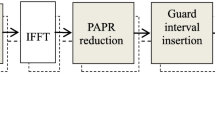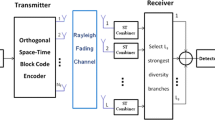Abstract
In MIMO systems, Toeplitz codes, overlapped Alamouti codes (OACs), and embedded Alamouti codes (EACs) can achieve full diversity when linear receivers are used. However, these codes have a large number of zero entries in their codeword matrix. Due to the zero entries in the design, the peak-to-average power ratio (PAPR) is high, and the transmitting antennas need to be switched on and off imposing severe hardware constrains. To solve this problem, in this paper, we propose a design scheme for no-zero-entry full diversity space-time block codes (NZE-STBCs). New no-zero-entry Toeplitz codes (called NZE-TCs) are designed first, and are then combined/overlaid with orthogonal space-time block code, Alamotui code, to construct no-zero-entry overlapped Alamouti codes (NZE-OACs) and no-zero-entry embedding Alamouti codes (NZE-EACs). The full diversity properties of proposed NZE-TCs, NZE-OACs, and NZE-EACs with linear receiver are derived. Simulation results show that our proposed codes outperform the Toeplitz codes, OACs, and EACs under peak power constraint, while performing the same under average power constraint.


Similar content being viewed by others
References
Vucetic B, Yuan J-H (2003) Space–time coding. Wiley, Chichester
Guey J-C, Fitz MP, Bell MR, Kuo W-Y (1999) Signal design for transmitter diversity wireless communication systems over Rayleigh fading channels. IEEE Trans Commun 47(4):527–537
Tarokh V, Seshadri N, Calderbank AR (1998) Space-time codes for high data rate wireless communication: performance criterion and code construction. IEEE Trans Inf Theory 44(2):744–765
Alamouti SM (1998) A simple transmit diversity technique for wireless communications. IEEE J Sel Areas Commun 16(8):1451–1458
Tarokh V, Jafarkhani H, Calderbank AR (1999) Space-time block codes from orthogonal designs. IEEE Trans Inf Theory 45(5):1456–1467
Ganesan G, Stoica P (2011) Space-time block codes: a maximum SNR approach. IEEE Trans Inf Theory 47(4):1650–1656
Wang H, Xia X-G (2003) Upper bounds of rates of complex orthogonal space-time block codes. IEEE Trans Inf Theory 49(10):2788–2796
Liang X-B (2003) Orthogonal designs with maximal rates. IEEE Trans Inf Theory 49(10):2468–2503
Su W, Xia X-G, Liu KJR (2004) A systematic design of high-rate complex orthogonal space-time block codes. IEEE Commun Lett 8(6):380–382
Lu K, Fu S, Xia X-G (2005) Closed-form designs of complex orthogonal space-time block codes of rates (k + 1)/2k for (2k-1) or 2k transmit antennas. IEEE Trans Inf Theory 51(12):4340–4347
Su W, Batalama SN, Pados DA (2006) On orthogonal space-time block codes and transceiver signal linearization. IEEE Commun Lett 10(2):91–93
Jafarkhani H (2001) A quasi-orthogonal space-time block code. IEEE Trans Commun 49(1):1–4
Tirkkonen O, Boariu A, Hottinen A (2000) Minimal non-orthogonality rate 1 space-time block code for 3-Tx antennas. Proc. IEEE Int. Symp. Spread Spectrum Tech. Appl. (ISSSTA’00), NJ, pp 429–432
Papadias CB, Foschini GJ (2003) Capacity-approaching space-time codes for systems employing four transmitter antennas. IEEE Trans Inf Theory 49(3):726–732
Sharma N, Papadias CB (2003) Improved quasi-orthogonal codes through constellation rotation. IEEE Trans Commun 51(3):332–335
Su W, Xia X-G (2004) Signal constellations for quasi-orthogonal space-time block codes with full diversity. IEEE Trans Inf Theory 50(10):2331–2347
Khan ZA, Rajan BS (2006) Single-symbol maximum likelihood decodable linear STBCs. IEEE Trans Inf Theory 52(5):2062–2091
Yuen C, Guan YL, Tjhung TT (2005) Quasi-orthogonal STBC with minimum decoding complexity. IEEE Trans Wirel Commun 4(5):2089–2094
Wang H, Wang D, G-Xia X (2009) On optimal quasi-orthogonal space–time block codes with minimum decoding complexity. IEEE Trans Inf Theory 55(3):1104–1130
Zhang J-K, Liu J, Wong KM (2005) Linear Toeplitz space time block codes. Proc. IEEE Int. Symp. Inf. Theory (ISIT’05), Adelaide, Australia. pp 1942–1946
Liu J, Zhang J-K, Wong KM (2008) Full-diversity codes for MISO systems equipped with linear or ML detectors. IEEE Trans Inf Theory 54(10):4511–4527
Shang Y, Xia X-G (2008) Space-time block codes achieving full diversity with linear receivers. IEEE Trans Inf Theory 54(10):4528–4547
Zhang W, Yuan J (2009) A simple design of Space-time block codes achieving full diversity with linear receivers. Proc. Int. Conf. Acoustics, Speech and Signal Processing (ICASSP’09), Taipei, Taiwan, pp 2729–2732
Wang H-M, Xia X-G, Yin Q-Y, Li B (2009) A family of space-time block codes achieving full diversity with linear receivers. IEEE Trans Wireless Commun 57(12):3607–3617
Yuen C, Guan YL, Tjhung TT (2008) Power-balanced orthogonal space-time block code. IEEE Trans Veh Technol 57(5):3304–3309
P Van Bien, W Sheng, X Ma, H Wang (2011) No-zero-entry STBC scheme of achieving full diversity with linear receiver. In: Proceeding of 2011 International Conference on Advanced Technologies for Communications (ATC 2011), DaNang, Vietnam, pp 212–215
Dayal P, Varanasi MK (2005) Maximal diversity algebraic space-time codes with low peak-to-mean power ratio. IEEE Trans Inf Theory 51(5):1691–1708
Author information
Authors and Affiliations
Corresponding author
Appendixes
Appendixes
1.1 Appendix 1—Proof of Lemma 2
Firstly, we rewrite Toeplitz matrix \( \mathbf{\mathcal{T}}\left(\mathbf{v},\mathrm{L},\mathrm{K}\right) \) given in (5) as
where T 1 and T 3 are matrices of size (K-1) × L constructed by the K-1 first rows and the K-1 last rows of the Toeplitz matrix \( \mathbf{\mathcal{T}}\left(\boldsymbol{v},L,K\right) \), respectively, and T 2 is a matrix of size (L-K + 1) × L constructed by the remaining rows of \( \mathbf{\mathcal{T}}\left(\boldsymbol{v},L,K\right) \). Next, we rewrite NZE-Toeplitz matrix (10) as

where  , 0 is the all-zero matrix of size (L-K + 1) × L. It is not difficult to check that
, 0 is the all-zero matrix of size (L-K + 1) × L. It is not difficult to check that

Hence, we have

The first inequality holds because \( {\mathbf{\mathcal{T}}}^{\mathrm{H}}\mathbf{\mathcal{T}} \) and ℬ 1 H ℬ 1 are positive semidefinite matrices, and the second inequality comes from the result in Lemma 1. This means inequality (10) holds. The proof for inequality (11) is similar.
1.2 Appendix 2—Proof of Theorem 2
Lemma 3
With F(v,M,L) given in (24) and G(v,M,L) in (26), we always have
A proof of Lemma 3 is similar as that of Lemma 2.
By considering the equivalent channel matrix ℋ of the NZE-OAC in (28) and using Lemma 3, we have

On the other hand, Theorem 2 in [22] has shown that
with any nonzero h, and c is a positive constant independent of h.
From (50) and (51), we conclude that matrix ℋ H ℋ is nonsingular for any nonzero h. ℋ is the equivalent channel matrix of the NZE-OACs given in (28).
Rights and permissions
About this article
Cite this article
Pham, VB., Sheng, WX. No-zero-entry full diversity space-time block codes with linear receivers. Ann. Telecommun. 70, 73–81 (2015). https://doi.org/10.1007/s12243-014-0429-4
Received:
Accepted:
Published:
Issue Date:
DOI: https://doi.org/10.1007/s12243-014-0429-4




